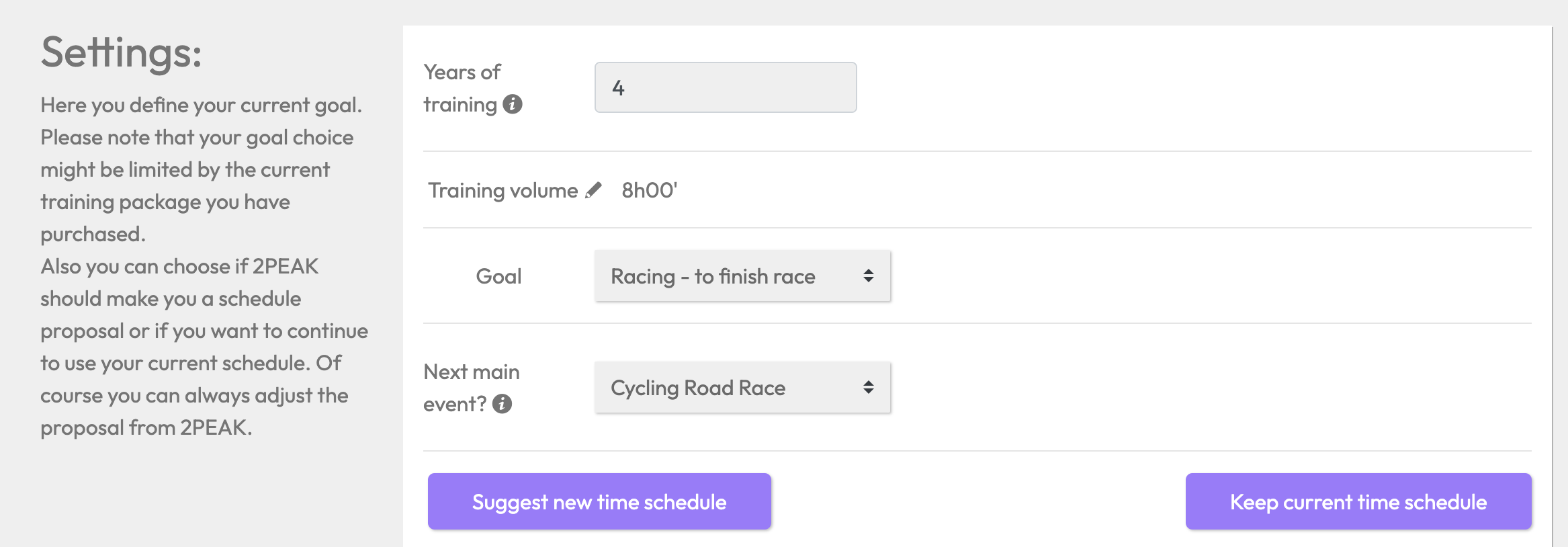Professional cyclists and triathletes are known to train up to more than 30 hours a week, but what is the right amount of training for us mere mortals? Whether you’re a beginner, intermediate, or experienced athlete, deciding how often to train can be challenging. There’s no one-size-fits-all answer, but regardless of experience, here are some key factors to consider when determining your training frequency.
Customized training plan based on your parameters
When creating a training plan with 2PEAK, you enter the days you can train and the duration of each session. The question of how often to train and how to adapt the plan is frequently asked. 2PEAK offers a function to determine the appropriate training volume for the user based on their training experience and goals. You can find it in My Settings > Average Weekly Training Hours > Change > Suggest new time schedule.

By clicking here on “Suggest new time schedule,” a suggested training volume based on your experience and goals will be provided. Note that this function is available only in the browser version. However, if you still want to make small manual adjustments or understand the aspects to consider for fine-tuning, there are several things to keep in mind.
This article focuses on cyclists and triathletes. If you’re training for a running race, check out the article “How Often Should I Run?“
Determining my daily routine commitments
The first thing to consider when establishing your training frequency is how your schedule aligns with other commitments. While professionals may train for 30 hours a week, even if amateurs were physically capable, it might not be feasible with a full-time job and family responsibilities. The activities you engage in during the 18-23 hours when you’re not training not only limit available time but also influence recovery and, consequently, training.
Find time slots for regular training in your weekly schedule. Consistency is crucial. Can you regularly schedule an hour of training in the morning before work, during lunch break, or in the evening after work? Do you have time on weekends or perhaps mid-week for a longer session? Does waking up at 5 am every day for training make sense, and how does it impact sleep and, therefore, recovery?
2PEAK visually shows your recovery progress and actively adjusts your training accordingly. Recovery is automatically calculated and displayed in the recovery battery. You can also manually adjust the recovery status calculated by 2PEAK at any time, for example, in case of work stress or insufficient sleep. The battery learns from your adjustments and adapts future training sessions to the new conditions.
What are my goals?
Are you training to stay healthy or to become the fastest and strongest athlete? The training frequency varies based on your athlete category. If you’re a “for fun” athlete mainly concerned with overall health, 2 or 3 training sessions per week might be sufficient. In this case, ensure you get enough daily physical activity and consider incorporating other forms of exercise like pilates or strength training into your program. With 2PEAK’s multisport feature, you can discover how different training forms affect recovery and performance.
If you truly want to maximize your potential, you need to train more. There’s no way around it. If the goal is genuinely to be the best, and you have the necessary time, significant progress can be made this way. Many performance-oriented enthusiasts invest around 10 hours per week in their training. Most ambitious athletes wanting to be as fast as possible can effectively manage this training volume. Ambitious athletes should also consider planning two sessions in one day to fully leverage their potential.
What is the distance of my main race?
Are you training for a short one-day race, a multi-stage cycling race, or an Ironman? For ambitious athletes, training times for shorter races are not significantly different from those for longer races. Professional triathletes dedicated to sprint triathlons can train for more than 30 hours a week.
Of course, most athletes don’t have unlimited time. In this case, the required training time depends on the distance of the main race. If you’re training for a shorter race, excellent results can be achieved with less than 10 hours per week. For athletes severely limited by time, frequent, shorter, and intense sessions will be more beneficial than longer ones. However, long training sessions are crucial if you’re preparing for a longer race.
How many breaks should I take?
Adaptation and improvement come from a combination of training load and body recovery through rest (supercompensation). A crucial component of training frequency is the amount of body recovery. Smart training is always organized with a periodic training plan that includes and takes into account rests.
For more ambitious athletes, a rest break might be a relaxed training session, while athletes who generally subject their bodies to less stress should work with rest days. Additionally, younger athletes tend to recover faster than older ones. If you’re an older athlete, we recommend reading our article on training for those over 50.
Other considerations
The amount of training can also be influenced by injury history and the type of sport practiced.
If you’re more prone to injuries, consider reducing training volume or engaging in an alternative sport on some days. A time-saving tip for triathletes, allowing increased training volume, is to incorporate brick training, meaning running immediately after getting off the bike. The same logic can be applied to cyclists wanting to complete a short power unit after training.
Triathletes should also consider the sport they practice when determining training volume. Cycling, swimming, and running have different training loads and recovery times. When setting up training in 2PEAK, you can let 2PEAK select the sport for a particular session. It’s a valuable tool as 2PEAK analyzes which sport needs more attention and suggests accordingly. However, this shouldn’t be done for every training session, as there isn’t always time to go swimming or take a long bike ride.
Conclusion
Here are some key points to keep in mind for your training schedule:
- Plan customization: Utilize advanced tools like 2PEAK to create a personalized plan based on your goals and training experience.
- Consistency in training: Find regular time slots in your daily calendar to ensure fundamental consistency for long-term success.
- Adaptation to race distance: The training volume should reflect the distance of your main race, ensuring your effort is proportionate to the goal.
- Recovery and Rest: Intelligent recovery management is crucial. Incorporate rest breaks or light workouts to maximize supercompensation.
- Individual considerations: Your injury history and the type of sport practiced impact your programming. Make adjustments to maintain a balance between load and recovery.
Create an AI-based training plan for triathlon, cycling, and running with 2PEAK that adapts to your performance after each workout. Download the app and start revolutionizing your training.


